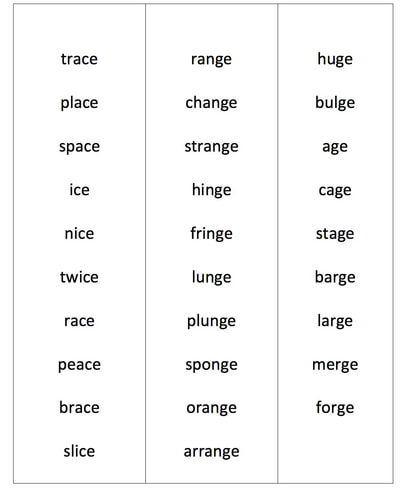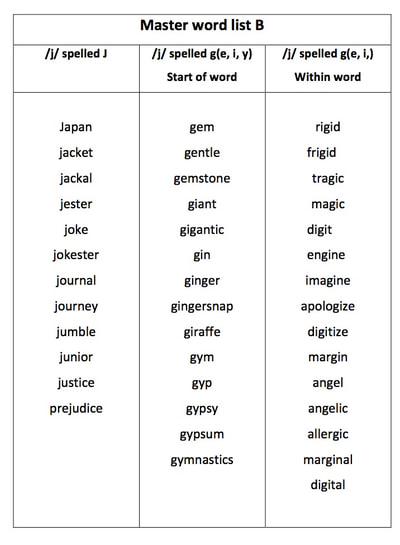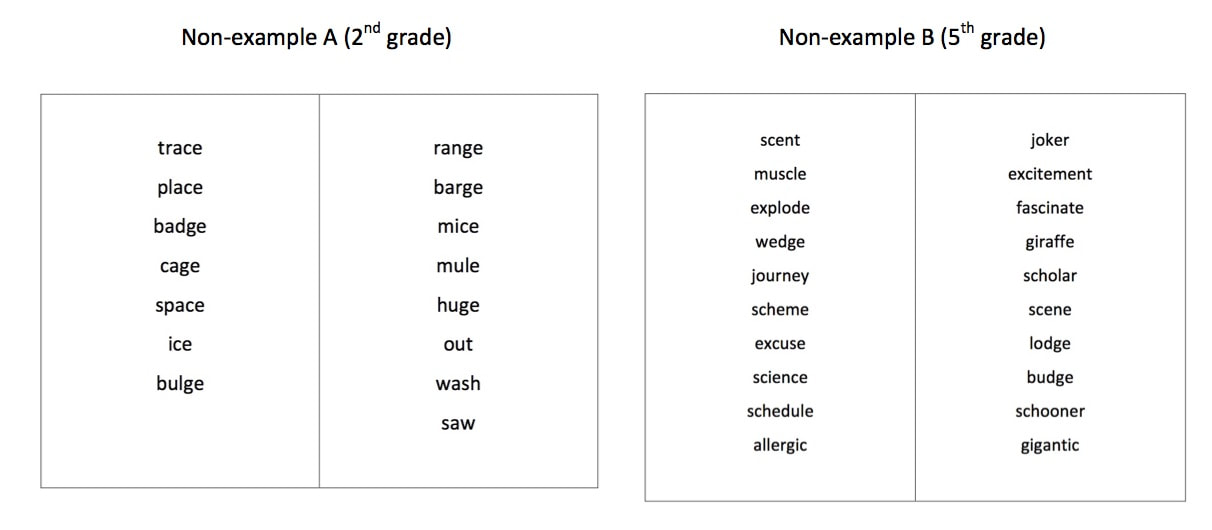|
As with my previous blog about the master spelling list, this post has a companion video. You can find it on my YouTube Channel in the Development from the Drums series. Here’s the link: bit.ly/MstSpl2. Now, more thoughts on creating a master spelling list. An effective spelling list is a nuanced thing: developmentally appropriate, not too broad in the concepts it teaches, varied in its levels of word difficulty, designed for differentiation, inclusive of words often used in writing, and flexible enough to be used with a variety of instructional activities. Three Guidelines To start, here are three guidelines for creating an effective master spelling list for every spelling lesson: 1.Begin by narrowing what you want to teach. For children in the early and early middle stages of spelling development, keep your list focused on only one to three features (sound-letter relationships or spelling patterns). For children in the more advanced stages, keep your list to four concepts (patterns, Latin/Greek roots, affixes, etc.). But narrow is only half the formula. The list also needs to be deep. By deep I mean that the list has a great variation on a few simple themes. Variation within a narrow range of features allows you to differentiate, scaffold your instruction, and expose students to words they might see while reading and writing. 2. As you consider words for making your list deeper, try to choose words that have high utility for students when they write. For example, if you are teaching the I-consonant-E pattern to second graders, pick words like ice, mile, and inside, rather than vice, fife, and incite. While these words are useful for writing the sentence, “His one great vice was inciting fife playing,” I doubt that any second grader would ever write it. 3.Construct a master list at least 30 to 40 words long. Every word should be built upon the two to four spelling ideas you want to teach. Use some of the words in a pre-test. After giving a pre-test, use other words to construct a weekly word lists for students. Or make two or three differentiated lists for groups of students. In this way, you can teach to a variety of achievement levels, varying word length and/or word meaning but staying within the parameters of guideline number one. Focus on two to four spelling features When lists are focused, teachers have a better understanding of what, exactly, they are teaching. They are also better able to assess whether students have truly mastered a sound-letter combination, pattern, suffix, root word, etc. Meanwhile, students have a better chance of mastering whatever is being presented. I believe you will have more success teaching English language learners and struggling readers to read and write when your lesson’s word list is narrow and deep. If you present too many features with too few examples, your lesson isn’t anchored. And if your lesson isn’t anchored, your learners won’t learn - they’ll just memorize now and forget later on. But if your list consists of two to four main roots, and if each root has a great many words branching from it, your students will have the chance to grow deep spelling roots of their own, roots that will anchor and sustain them throughout their independent reading and writing. Balance spelling concepts and writing words When constructing a master list, think about the words children use in writing. A helpful resource for aligning spelling concepts with often-used writing words is The Basic Spelling Vocabulary List (Grahm, Harris, & Loynachan, 1993). Here’s a link to it at LDOnline: http://bit.ly/SplVcbLst. According to the authors, the spelling vocabulary list they present contains “850 words that account for 80 percent of the words children use in their writing — the ones they need to be able to spell correctly.” Also, use your teacher sense when constructing a list. As we teach within our grades, and as our students write, we increasingly gain a sense of what topics out students are writing about and what words they need to convey information on these topics. Consider keeping a small notebook labeled “Words for Writing” handy. In the notebook, jot down words you see children using in their writing or words that occur to you as you think about upcoming writing lessons. When it comes time to create a master list for any given spelling lesson, scan through the words you’ve listed to see if any work with the spelling concept you want to teach. Construct a master list To use a variety of spelling activities in your classroom, you need a large number of words at your disposal. Pulling in a mixture of words from a variety of sources gives you real options for instruction. A lengthy master word list allows you to do the following:
Here are two examples of a master spelling list. Both are modifications of the lists in my January 8 post. The first one works for students in the early stages of spelling development. The second is appropriate for students in later stages. Notice that both focus on only three spelling features.
Where do you get words for your master spelling list? First, I pull words from websites such as The Free Dictionary and Rhymezone. Second, I get words from rhyming dictionaries, such as The Scholastic Rhyming Dictionary by Sue Young. Third, I use the dictation books of the Wilson Reading System. And finally, I pull words from my own, aging grey matter. The mind is a terrible thing to waste and I’m doing my best to keep my brain sharp with a bit of word play and rhyming. In conclusion, a master spelling list focuses on a few key spelling concepts, is inclusive of writing words, is useful for non-worksheet activities that teach children how to spell, and is long enough to allow for individualization and re-teaching. Construct one and you’ll be well on your way to truly teaching spelling and giving your students a deeper understanding of words. Hard to believe it’s 2018! Onward and upward into the new year. One of my recent Tweets generated some discussion about spelling word lists, so my take on a spelling word list is the topic for this blog. And I’ll follow up with a companion piece in a couple of weeks. But before I launch into spelling lists, I want to point out that I’m writing this blog to coincide with the launch of my YouTube Channel, creatively titled “The Mark Weakland Channel.” The Mark Weakland Channel doesn’t feature sci-fi fantasies, comedy specials, or shows about British royalty. It will feature 5 to 7-minute video clips of me discussing topics related to all things literacy. Right now there’s only one video! But I’m learning. I’m calling my first series of videos “Development from the Drums” (because its alliterative and because I’ll be sitting behind my drum set to up the entertainment value). So please go to YouTube and listen as I yak about spelling and lay down a beat. Here’s the link: http://bit.ly/Spllist1. And now, thoughts on spelling word lists, starting with my idea of a master spelling word list. Within my philosophy of spelling, the master spelling list is a key component of instruction. Once created, its functions are many. It’s deep reservoir of words enable the creation of differentiated spelling lists. It provides words for modeling strategies and running activities. And it gives students many examples of just a few spelling features, thereby helping kids focus on sounds and letters, patterns, and the meaning making parts of words. Here’s an important point: a spelling list is NOT the main element of spelling instruction. Neither is it the “thing” that children are supposed to learn. A spelling list is simply a tool, one of many that you will use as you teach children HOW to spell words. As teachers, we want to teach children how to spell, not what to spell. To teach them how to spell, you need words (content), teaching techniques (instruction), and activities (for student practice, from guided to independent). Also, the weekly spelling list is one of a number of vehicles that move words from the page into the “mind dictionary” or lexicon of each student. This dictionary of the mind is critical for fluent reading. Because the purpose of spelling instruction is to help children become better readers and writers, it pays to have a bank of spelling words that is narrow and deep. By narrow I mean that your spelling instruction for the week does not include too many spelling features and concepts. If you have too many features in your master list, you won’t be able to repeatedly point out (through modeling, instruction, and guided and independent practice) the features and concepts that you want your students to focus on, learn, and apply in all types of reading and writing situations. Here are two non-example lists. When it comes to helping children become better readers through spelling, these types of lists do not help the cause, especially for children who struggle to read and write. The first is from the 2nd grade curriculum of a big publisher basal reading series. The second is a 5th grade list, also from a well-known basal reading series. Although the 2nd grade list is more focused, both lists have too many spelling features and too few words that provide examples of each feature. In a nutshell, these lists are too wide and too shallow, especially the 5th grade list. Here is my thinking about why:
In my next blog, I’ll expound a bit more on how you narrow a spelling list and then bring in words to create a master spelling list. And I’ll give two examples of master spelling lists. If you’re interested in hearing me say what I’ve just written (but in a slightly different way, and with a little drumming), then visit my YouTube channel “Mark Weakland” and check out my video. And consider clicking the SUBSCRIBE button to become a regularly informed viewer. |
Mark WeaklandI am a teacher, literacy consultant, author, musician, nature lover, and life long learner.
|



 RSS Feed
RSS Feed